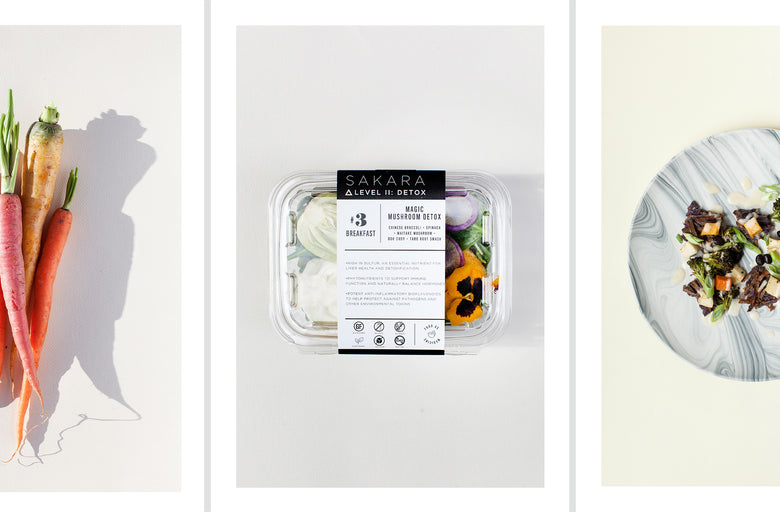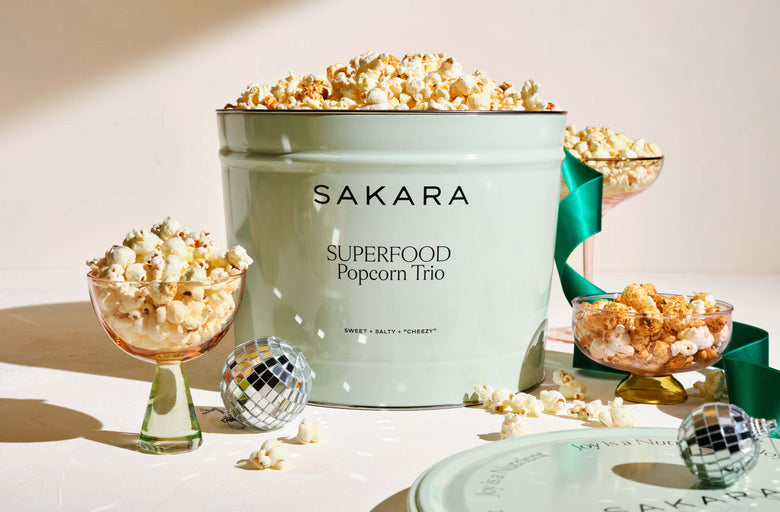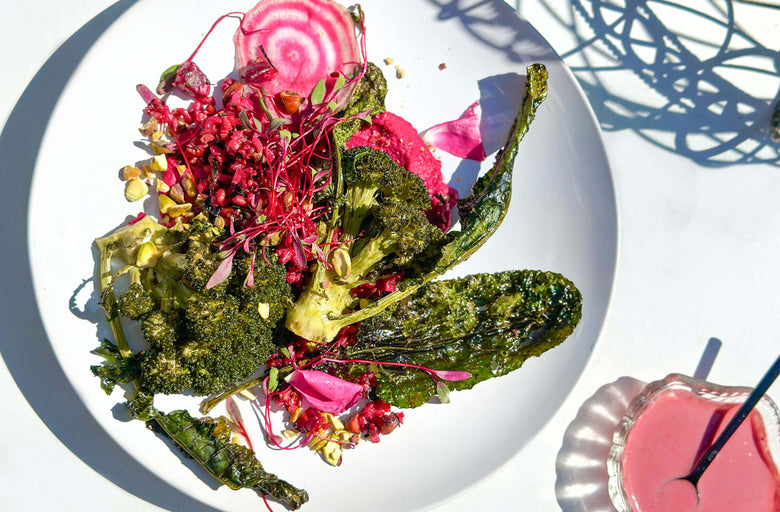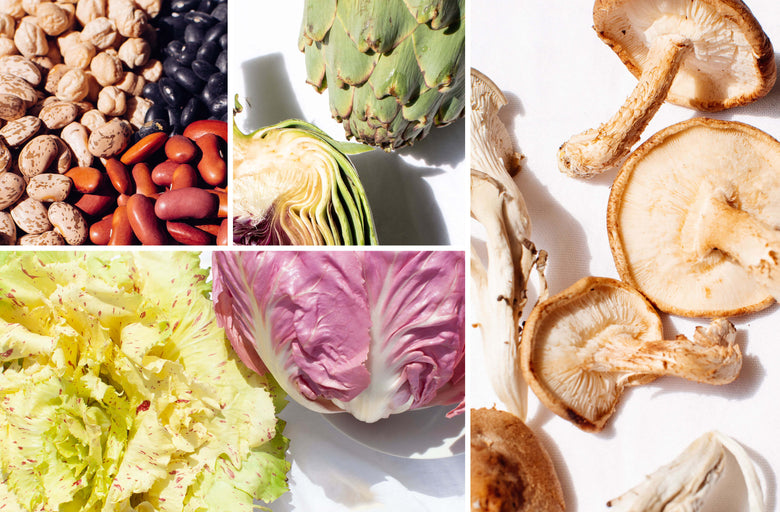Sugar: to those invested in their health, it's a dirty word. Just as the ‘90s misunderstood and mislabeled fat as “bad,” the new villain in the grocery store is anything sweet. But we prefer to focus on food's power to nourish, heal, and bring pleasure—not strike fear and impose restrictions. Where's the joy in that?
When it comes to all that is saccharine, the conversation is a lot more nuanced than "good" or "bad." Instead of writing it off completely, concern yourself with quality, sourcing, and in what form you’re consuming the sweet stuff. A factory-made piece of candy registers dramatically different in the body than a juicy, organic peach dripping down your arm, or even a scone made with nut flours and raw honey. So, let’s take fear out of the equation and get informed on the different types of sugar, why your microbiome could be the likely culprit of your “addiction,” and how to reclaim power over your body by what you put in it.
Sugar 101
There are a few different types of sugar, but two of the most common forms are glucose and fructose:
Glucose is a monosaccharide, meaning it’s the most basic of carbohydrates (i.e. a simple carbohydrate). But just because it’s basic doesn’t mean it isn’t important — rather, glucose is the body and brain’s #1 energy source. When we refer to blood sugar, we’re talking about glucose, since it’s carried through your blood and either used immediately for energy or stored (in the muscles or liver) to be used later on. When your blood sugar or your glucose level, rises, insulin shows up to help welcome that glucose into your cells.
Insulin, which is released by the pancreas to metabolize sugar, isn’t all bad — it has some important jobs, including promoting muscle growth. But insulin spikes set off a chain reaction of ill effects in the body. First of all, insulin moves glucose from the blood to the muscle and fat cells. This causes the dreaded blood sugar crash, otherwise known as hypoglycemia. You feel shaky and weak and you’ll often end up overeating as a result. Insulin spikes also cause the body to store more fat, raises your bad cholesterol while lowering the good kind, disrupts the hormones responsible for mood and sex drive, and causes inflammation, which can manifest as acne and other skin issues.
Fructose is what gives fruit and starchy root veggies their sweetness. Only the liver can metabolize fructose (so in some ways it’s more like fat than a typical carbohydrate), and it doesn’t trigger the release of insulin or leptin, a hormone associated with feelings of hunger and satiety. It’s also one of the sugar structures found in refined table sugar (a.k.a. sucrose). That’s why fructose gets a bad rap sometimes. But more on that later.

How do you get addicted to sugar?
You may have heard that you can be addicted to sugar just like you can be addicted to drugs and alcohol. Sounds extreme, but it’s true on a biochemical level. Sugar activates the reward centers of your brain, releasing a flood of the feel-good hormone dopamine. As you eat more sugar, your dopamine receptors start to down-regulate, making you less sensitive to said dopamine and blunting the effects of sugar over time. Think of it like building a tolerance to sugar — as time goes on, you need a bigger and bigger hit to achieve the same high. Every bite you take just leaves you wanting more. Some health and wellness experts, including Dr. Mark Hyman, believe sugar may in fact be even more addictive than cocaine. Scary stuff, right?
So what about the sugar in fruit?
Some anti-sugar purists put fruit in the same category as, say, Oreos, but that’s oversimplifying things quite a bit. Yes, fruit contains sugar. But it’s what accompanies that sugar that’s so important—in this case, fiber—because it affects absorption significantly. One big problem with the refined sugar found in processed foods is that it is metabolized so quickly; if you don’t burn it off quick, it will be stored as fat (not to mention, you’ll still feel hungry). The all-important fiber found in fruit works in tandem with the sugar to slow the glucose transition and digestion processes, fill you up and prevent a harmful blood sugar spike. Plus, there’s a lot more nutrition in a cup of blueberries than a candy bar—more than 13,000 cell-protecting, age-fighting antioxidants, for instance. So nutrient density comes into play as well. At Sakara, we create meals with a 10:1, and often 5:1, carbohydrates to fiber ratio to eliminate insulin spikes, gut upset, and bloat. That being said, different fruits rank differently on the glycemic index; if you’re worried about fruit spiking your blood sugar, choose low G.I. fruits like berries and apples over high G.I. fruits like pineapple and bananas. And whole fruit is better than juice for reaping those fibrous benefits.
Do I need to quit sugar?
You might want to cut back. The effects of an overly sugary diet are many…perhaps you’ve even experienced some of them. There are the obvious ones, like weight gain and diabetes. But consuming too much sugar also bumps up your blood pressure and cholesterol and puts you at an increased risk of heart disease and certain cancers. Sugar also feeds candida yeast (the bad kind of bodily bacteria) and causes it to grow. This leads to inflammation (which could manifest as anything from acne to autoimmune disorders) and weakens your immune system.
How does eating clean cure a sugar addiction?
Remember, food is medicine. If sugar is making you sick, eating clean can be the cure. In fact, it’s the best cure available. A diet of whole, all-natural plant foods will reset your system, help detoxify your body, and restore blissful balance. Here are 5 ways a clean diet can help cure sugar addiction:
1. Eating clean ensures you’re fully nourished. As humans we are hard-wired to crave sweet foods when we’re deprived of nutrients. The brain runs on glucose! And we’ve developed a preference for sweets as a survival mechanism…to keep our ancestors from eating toxic, unsafe plants. But if you’re eating a diet that’s rich in a wide variety of whole, natural, nutrient-dense, functional plant foods, you won’t be deprived in the first place. You’ll be nourished by the magic of functional foods — those that go above and beyond simple nutritive value to provide extra body-supporting benefits. With the right balance of fresh, colorful fruits and veggies, plant-based protein, satisfying whole grains and healthy fats, you’ll not only be getting all the nutrients you need, but your body will be able to assimilate and take full advantage of all of it. The result? No nutrient deprivation, and no emergency sugar binge.
2. Eating clean balances your gut flora. Your microbiome eats what you eat. And what you eat dictates how healthy and thriving those healthy gut bacteria are (and in turn, how healthy you are). When you eat clean foods like leafy greens and fresh produce, you encourage the vibrant growth of good-for-you bacteria, which will give you glowing skin, smooth digestion and balanced hormones. But eating a lot of sugar encourages candida yeast to thrive. This not only throws your system off (think bloating, skin irritations, chronic fatigue and of course, yeast infections) but also causes you to crave even more sugar. The lesson here? Eat clean, encourage healthy bacteria to flourish, and kick that candida to the curb.
If sugar is making you sick, eating clean can be the cure. In fact, it’s the best cure available.
3. Eating clean retrains your taste buds. Shifting your eating habits, particularly when you’re used to eating a lot of artificially flavored, super-sugary, heavily processed foods, is a major transition. Your body may be used to these larger-than-life sweet flavors, and it can feel like that’s the only thing that will satisfy. At first, loading up on greens or eating a piece of fruit when you’d normally turn to a bag of M&Ms feels like an uphill battle. But take some time away from the fake stuff and you’ll eventually regain the natural sensitivity of your taste buds. You’ll start to get used to what real food actually tastes like. And you’ll eventually start to crave them. A ripe, juicy strawberry at the height of the season tastes so much better than strawberry-flavored yogurt, full of artificial additives and crazy chemicals, promise.
4. A clean diet keeps you energized without ups and downs. Clean, fresh, healing plant foods do their part to keep you energized and clear-minded, meaning you’re less likely to fall victim to a blood sugar crash. The right balance of healthy fat, clean protein, and satiating fiber will give you sustained energy without a blood sugar spike, and in turn, help curb your cravings or leave you grabbing anything in sight to cure your hypoglycemic state.
5. When you reset and repair your relationship with food, you’ll be less susceptible to emotional eating. Think about it; how often does a stressful day at work or a fight with your significant other lead to a binge of raw veggies and hummus? Usually, in times of crisis, we turn to sugary or high-carb foods because we’re conditioned to think of them as comforting (plus, we crave the temporarily mood-lifting serotonin surge they bring). But when you break free of emotional eating by recalibrating your habits and replacing them with healthier ones, you’ll reap benefits that extend to a loving, grateful relationship with your body and with food. And really, what could be sweeter than that?
Foods for Vibrant Health and a Radiant Body
The Grocery List for Mental Health






